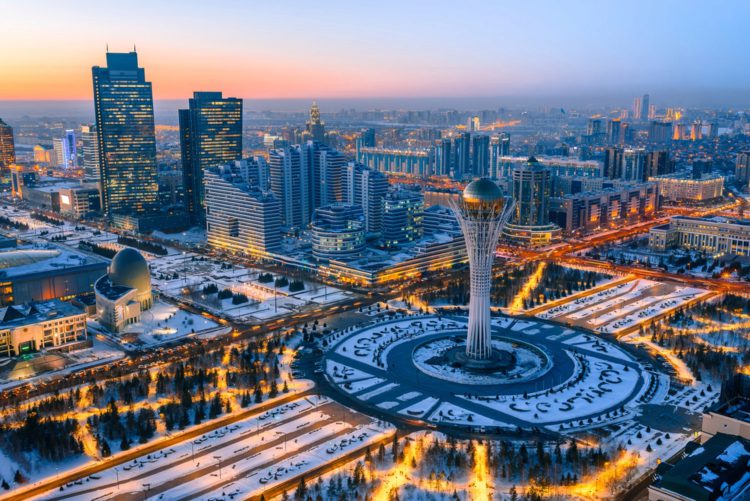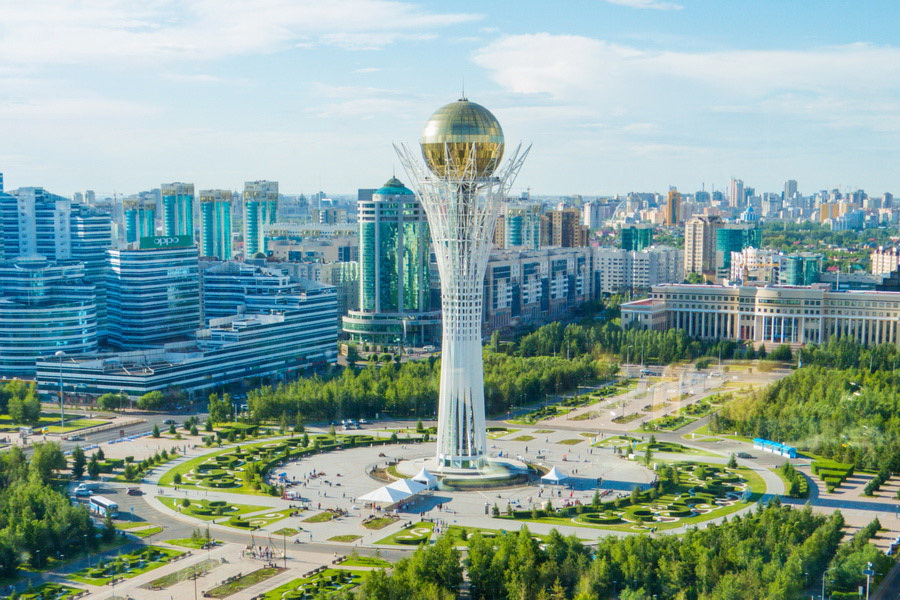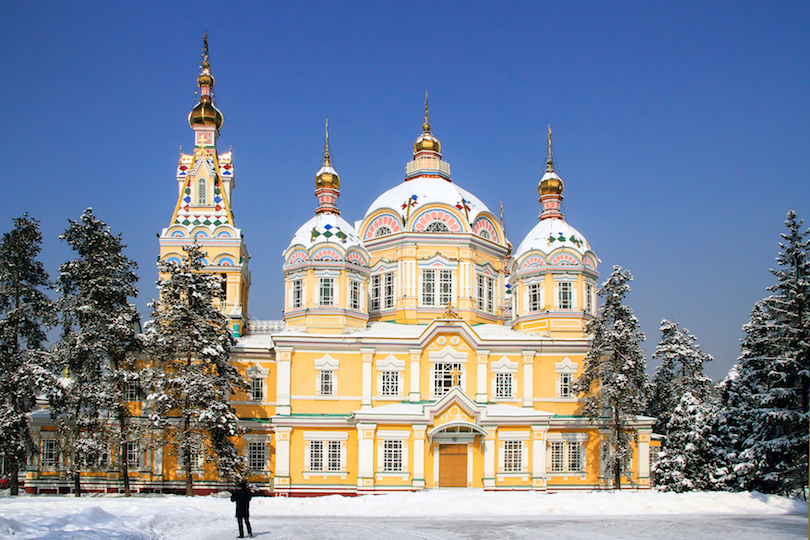
Nestled in the vast embrace of Central Asia, Kazakhstan is a land of captivating contrasts, where ancient Silk Road legends intertwine with futuristic cityscapes, and majestic mountains give way to endless steppes. As the world’s largest landlocked country, it boasts a geographical diversity that few nations can rival, offering a treasure trove of experiences for the intrepid traveler. From the cosmopolitan flair of its major cities to the serene beauty of its untouched wilderness, Kazakhstan is an emerging destination that promises an unforgettable journey into the heart of a vibrant and historically rich culture.
This sprawling nation, larger than all of Western Europe, invites exploration with its dramatic landscapes, deep-rooted traditions, and a history that echoes through its ancient monuments and modern marvels. Prepare to be enchanted by its unique blend of nomadic heritage, Soviet-era legacy, and burgeoning contemporary identity.
Top Attractions: A Mosaic of Wonders

Related Articles about Kazakhstan: Unveiling the Heart of Central Asia:
- Hungary: A Tapestry of History, Culture, and Unforgettable Attractions
- Unveiling the Treasures of Qatar: A Comprehensive Guide to its Top Attractions
- Unveiling the Treasures of Arabia: A Comprehensive Guide to Saudi Arabia’s Top Attractions
- The Electric Heart of Vietnam: An Insider’s Guide to Ho Chi Minh City
- Florence: A Renaissance Dream and Your Guide to the Perfect Stay
Kazakhstan’s vastness translates into an incredible array of attractions, catering to every kind of traveler – from the adventure seeker and history buff to the cultural enthusiast and urban explorer.
Almaty: The Southern Capital and Gateway to the Mountains
Often referred to as the "Garden City," Almaty is Kazakhstan’s former capital and its largest metropolis, nestled at the foot of the magnificent Tian Shan mountains. Its tree-lined avenues, vibrant cultural scene, and proximity to stunning natural wonders make it an ideal starting point for any Kazakhstani adventure.
- Big Almaty Lake (BAO): Just a short drive from the city, this breathtaking alpine lake is a jewel of turquoise and azure, reflecting the surrounding peaks. A popular spot for hiking and photography, its color changes with the seasons, offering a different spectacle each time.
- Kok Tobe Hill: Ascend via a scenic cable car to Kok Tobe Hill for panoramic views of Almaty, especially stunning at sunset. The hill also features a small amusement park, a zoo, and a statue of The Beatles.
- Zenkov Cathedral (Ascension Cathedral): A marvel of wooden architecture, this Russian Orthodox cathedral in Panfilov Park was built entirely without nails. Its vibrant exterior and intricate interior are a testament to early 20th-century craftsmanship.
- Medeu Skating Rink & Shymbulak Ski Resort: A short bus ride from Almaty, Medeu is the highest-altitude outdoor speed skating rink in the world. Further up, Shymbulak offers world-class skiing and snowboarding, even in summer, with stunning mountain vistas.
- Charyn Canyon: Often dubbed the "Grand Canyon’s little brother," Charyn Canyon is a geological wonder located about 200 km east of Almaty. Its most famous section, the "Valley of Castles," features dramatic, wind-sculpted rock formations that ignite the imagination, creating a truly otherworldly landscape.

Nur-Sultan (Astana): The Futuristic Capital of the Steppe
Nur-Sultan, formerly Astana, is Kazakhstan’s purpose-built capital, a dazzling showcase of modern architecture and ambition that rose from the desolate steppes. Its futuristic skyline is a stark contrast to the country’s nomadic past, symbolizing its forward-looking vision.
- Baiterek Tower: The iconic symbol of Nur-Sultan, this monument represents a local folk tale about a mythical tree of life and a magic bird. Visitors can ascend to the observation deck for a 360-degree view of the city and place their hand in the golden imprint of the First President’s palm.
- Khan Shatyr Entertainment Center: An architectural marvel, this giant transparent tent, designed by Norman Foster, houses shops, restaurants, entertainment venues, and even an indoor beach with sand imported from the Maldives.
- Palace of Peace and Reconciliation (The Pyramid): Another Norman Foster masterpiece, this striking pyramid-shaped building serves as a venue for the Congress of Leaders of World and Traditional Religions, symbolizing peace and harmony.
- Hazrat Sultan Mosque: One of Central Asia’s largest mosques, its stunning white marble, intricate Islamic patterns, and towering minarets make it a breathtaking sight.
- National Museum of Kazakhstan: A must-visit to understand the nation’s rich history and culture, featuring impressive exhibits, including the famous "Golden Man" archaeological find.
Turkestan: The Spiritual Heart of Kazakhstan
In the southern part of the country lies Turkestan, an ancient city steeped in history and spirituality. It was a pivotal point on the Silk Road and remains a significant pilgrimage site.
- Mausoleum of Khoja Ahmed Yasawi: A UNESCO World Heritage site, this unfinished mausoleum is an architectural masterpiece commissioned by Timur (Tamerlane) in the late 14th century. Its intricate tilework, massive dome, and spiritual significance make it a profound place to visit, representing the spiritual heart of the Kazakh people.
Natural Wonders Beyond the Cities
Kazakhstan’s national parks and remote regions offer unparalleled natural beauty.
- Kolsai Lakes & Kaindy Lake: Located in the northern Tian Shan mountains, the Kolsai Lakes are a series of three pristine alpine lakes, perfect for hiking, horseback riding, and camping. Nearby, Kaindy Lake is famous for its "sunken forest," where submerged spruce trees rise eerily from its turquoise waters, creating a surreal landscape.
- Altyn Emel National Park: This diverse park is home to the Singing Dunes, a natural phenomenon where the sand emits a low hum or roar on windy days. The park also features the otherworldly Aktau Mountains, vibrant geological formations in shades of white, red, and yellow, and ancient Besshatyr burial mounds.
- Mangystau Region: In Western Kazakhstan, the remote Mangystau region offers a starkly beautiful, almost Martian landscape. Highlights include the Bozjyra Tract with its dramatic rock formations, ancient underground mosques like Bekets Ata and Shakpak Ata, and the dramatic cliffs overlooking the Caspian Sea.
- Baikonur Cosmodrome: For those fascinated by space, Baikonur is the world’s first and largest operational space launch facility. While access requires special permits and pre-booked tours, witnessing a rocket launch from this historic site is an unparalleled experience.
A Journey Through Time: Kazakhstan’s Rich History
Kazakhstan’s history is as vast and varied as its landscapes, shaped by nomadic empires, the Silk Road, and the influences of great powers.
For millennia, the vast Eurasian Steppe was home to nomadic tribes – the Scythians, Huns, and later Turkic peoples – who carved out powerful empires and left behind a rich archaeological legacy, including the famous Golden Man artifacts. The Silk Road was a defining feature, with trade routes crisscrossing the land, fostering cultural exchange and the growth of vibrant cities like Turkestan.
The 13th century saw the arrival of the Mongol Empire under Genghis Khan, followed by the Golden Horde, which deeply influenced the region’s socio-political structure. By the 15th century, the Kazakh Khanate emerged, establishing a distinct Kazakh identity and a unique nomadic culture centered around horsemanship, pastoralism, and oral traditions.
The 18th and 19th centuries marked the gradual incorporation of the Kazakh lands into the Russian Empire, bringing profound changes. The 20th century, under Soviet rule, was a period of rapid industrialization, forced collectivization, and devastating famines. It also saw Kazakhstan become a site for nuclear testing and the launchpad for the Soviet space program at Baikonur.
With the collapse of the Soviet Union in 1991, Kazakhstan gained its independence, embarking on a new chapter of nation-building, economic development, and establishing its place on the global stage. This rich tapestry of history is visible in its ancient burial mounds, Silk Road caravanserais, Soviet-era monuments, and gleaming modern cities.
Practical Travel Tips for Exploring Kazakhstan
Venturing into Kazakhstan is an exciting prospect, and a few practical tips can enhance your experience:
- Visa Requirements: Kazakhstan offers visa-free entry for citizens of many countries (including EU, USA, Canada, Australia, UK, and others) for stays of up to 30 days. Always check the latest requirements based on your nationality before traveling.
- Currency: The local currency is the Kazakhstani Tenge (KZT). ATMs are widely available in cities, and credit cards are accepted in most hotels, larger restaurants, and shops. It’s wise to carry some cash for smaller vendors or rural areas.
- Language: Kazakh is the state language, and Russian is widely spoken and understood, especially in cities and among older generations. English is becoming more common in tourist areas, major hotels, and among younger people, but learning a few basic Russian phrases will be very helpful.
- Safety: Kazakhstan is generally a safe country for tourists. Standard precautions against petty crime in crowded areas are advisable. The local people are known for their hospitality.
- Etiquette: Kazakhs are very welcoming. When visiting religious sites, dress modestly. Always accept offers of food or drink, as refusal can be considered impolite. Tipping is appreciated but not mandatory.
- SIM Cards: Local SIM cards are affordable and easily purchased at airports or phone stores in major cities (e.g., Kcell, Beeline). Coverage is good in urban areas.
- Water: Drink bottled water only. Tap water is generally not safe for consumption.
Accommodation Options: From Luxury to Yurt Stays
Kazakhstan’s growing tourism infrastructure offers a range of accommodation choices to suit various budgets and preferences:
- Luxury Hotels: In Nur-Sultan and Almaty, you’ll find international five-star chains like The Ritz-Carlton, St. Regis, Marriott, Hilton, and Hyatt Regency, offering world-class amenities and service.
- Mid-range Hotels: Plentiful options are available in major cities and larger towns, providing comfortable rooms, modern facilities, and good value for money. Look for both international brands and local chains.
- Boutique Hotels: Especially in Almaty, charming boutique hotels are emerging, offering unique designs and personalized experiences.
- Guesthouses and Homestays: For a more authentic cultural immersion, particularly in smaller towns or near national parks (like Kolsai Lakes), guesthouses and homestays offer a chance to interact with local families and experience Kazakh hospitality firsthand.
- Hostels: Budget-friendly hostels are available in Almaty and Nur-Sultan, popular with backpackers and solo travelers.
- Apartments: Rental platforms like Airbnb are popular, offering apartments for short or long stays, providing more space and privacy, especially for families or groups.
- Yurts: For an unforgettable traditional experience, many tour operators and national parks offer stays in yurts (traditional nomadic dwellings), often equipped with modern comforts, allowing you to connect with Kazakhstan’s nomadic heritage under a blanket of stars.
Getting Around: Navigating the Vastness
Given Kazakhstan’s immense size, understanding its transportation network is key to planning an efficient itinerary:
- Flights: Domestic flights are the most efficient way to cover long distances between major cities like Almaty, Nur-Sultan, Aktau, and Shymkent. Air Astana (the national carrier) and SCAT Airlines operate frequent and reliable services.
- Trains: Kazakhstan Temir Zholy (KTZ) operates an extensive rail network. Overnight sleeper trains are a popular and comfortable option for intercity travel, offering a chance to see the vast landscapes unfold. Modern high-speed trains also connect Nur-Sultan and Almaty.
- Buses and Marshrutkas: Buses and smaller minibuses (marshrutkas) connect towns and cities and are a budget-friendly option for shorter to medium distances. They can be less comfortable than trains or planes.
- Taxis: In major cities, ride-hailing apps like Yandex Go and InDrive are widely used, convenient, and reasonably priced. For street taxis, negotiate the fare before starting your journey.
- Rental Cars: Car rentals are available in major cities, but driving conditions outside urban areas can be challenging, with varying road quality. A 4×4 vehicle is often necessary for exploring remote natural parks. For self-driving, an international driving permit is recommended.
- Organized Tours: For reaching remote natural attractions like Charyn Canyon, Kolsai Lakes, or Altyn Emel National Park, organized tours or hiring a private driver (often arranged through hotels or tour agencies) is highly recommended, as public transport can be limited and logistics complex.
Best Time to Visit: Seasons of Splendor
Kazakhstan experiences extreme continental climate with hot summers and very cold winters. The best time to visit largely depends on your planned activities:
- Spring (April-May): This is a beautiful time when the steppes burst into bloom with tulips and wildflowers. Temperatures are mild and pleasant for sightseeing and hiking, though occasional rain showers are possible.
- Summer (June-August): Summer is ideal for mountain activities, trekking in the Tian Shan, and enjoying the long daylight hours. While cities can be hot, especially in the south and west, the mountain regions offer a refreshing escape. This is peak tourist season.
- Autumn (September-October): Often considered the best time to visit. The weather is crisp and clear, with comfortable temperatures perfect for hiking and exploring. The foliage in the mountains turns to stunning golden hues, offering spectacular photographic opportunities.
- Winter (November-March): Kazakhstan transforms into a winter wonderland. While very cold with heavy snowfall, it’s the perfect season for winter sports enthusiasts, especially at the Shymbulak Ski Resort near Almaty. Cities like Nur-Sultan are beautifully illuminated, but access to some remote natural parks may be limited.
Conclusion: A Journey Awaiting Discovery
Kazakhstan is a land of untold stories, breathtaking landscapes, and a vibrant culture eager to be discovered. From the dazzling modernity of Nur-Sultan to the ancient spiritual heart of Turkestan, and the raw, untamed beauty of its canyons and mountain lakes, this Central Asian gem offers a travel experience unlike any other. It’s a destination where you can gaze upon futuristic architecture one day and sleep in a traditional yurt under a million stars the next. Prepare to be amazed by the warmth of its people, the richness of its history, and the sheer scale of its natural wonders. Kazakhstan is not just a place to visit; it’s an adventure to be lived, leaving an indelible mark on every traveler who dares to explore its depths.





